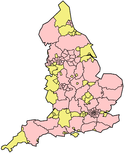Derby
| Derby | |||
|---|---|---|---|
| — U.A. & City — | |||
|
|||
| Motto: "Industria, Virtus, et Fortitudo" | |||
 |
|||
| Coordinates: | |||
| Sovereign state | United Kingdom | ||
| Constituent country | England | ||
| Region | East Midlands | ||
| Ceremonial county | Derbyshire | ||
| Admin HQ | Derby | ||
| Settled | AD 600 | ||
| City Status | 1977 | ||
| Government | |||
| - Type | Unitary authority, City | ||
| - Governing body | Derby City Council | ||
| - Leadership | Leader & Cabinet | ||
| - Executive | Lib Dem (council NOC) | ||
| - MPs | Margaret Beckett (L) Chris Williamson(L) |
||
| Area | |||
| - U.A. & City | 30.1 sq mi (78.03 km2) | ||
| Population (2006 est.) | |||
| - U.A. & City | 236,300 | ||
| - Density | 7,842.5/sq mi (3,028/km2) | ||
| - Urban | 236,300 | ||
| - Ethnicity (Office of National Statistics 2005 Estimate)[1] |
85.8% White 8.9% S. Asian 2.2% Black British 1.1% Chinese and other 2.0% Mixed Race |
||
| Time zone | Greenwich Mean Time (UTC+0) | ||
| Postcode span | DE1, DE3, DE21-24, DE73 | ||
| Area code(s) | 01332 | ||
| Grid Ref. | SK3533936187 | ||
| ONS code | 00FK | ||
| ISO 3166-2 | GB-DER | ||
| NUTS 3 | UKF11 | ||
| Demonym | Derbeian | ||
| Website | www.derby.gov.uk | ||
Derby (pronounced /ˈdɑ:bi/ (![]() listen), DAA-bi), is a city and unitary authority in the East Midlands region of England. It lies upon the banks of the River Derwent and is located in the south of the ceremonial county of Derbyshire. In the 2001 census, the population of the city was 233,700, whilst that of the Derby Urban Area was 229,407. According to the 2001 census, Derby was at that time the 18th largest settlement in England, measured by urban area.[2]
listen), DAA-bi), is a city and unitary authority in the East Midlands region of England. It lies upon the banks of the River Derwent and is located in the south of the ceremonial county of Derbyshire. In the 2001 census, the population of the city was 233,700, whilst that of the Derby Urban Area was 229,407. According to the 2001 census, Derby was at that time the 18th largest settlement in England, measured by urban area.[2]
Contents |
History
Origins
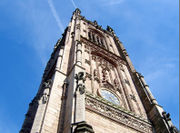
The city has Roman, Saxon and Viking connections. Derby recently celebrated its 2,000th year as a settlement.
The Roman camp of 'Derventio' was probably at Little Chester/Chester Green (grid reference SK353375); The site of the old Roman fort is at Chester Green. Later the town was one of the 'Five Boroughs' (fortified towns) of the Danelaw.
The popular belief is that the name 'Derby' is a corruption of the Danish and Gaelic Djúra-bý, recorded in Anglo-Saxon as Deoraby "Village of the Deer". However some assert that it is a corruption of the original Roman name 'Derventio'. The town appears as 'Darby' or 'Darbye' on early modern maps, such as that of Speed (1610).
Modern research (2004) into the history and archaeology of Derby has provided evidence that the Vikings and Anglo-Saxons probably co-existed, occupying two areas of land surrounded by water. The Anglo-Saxon Chronicle (c. 900) says that "Derby is divided by water". These areas of land were known as Norþworþig ("Northworthy", = "north enclosure") and Deoraby, and were at the "Irongate" (north) side of Derby.[4]
16th century - 18th century
During the Civil War of 1642-1646, Derby was garrisoned by Parliamentary troops commanded by Sir John Gell, 1st Baronet, who was appointed Governor of Derby in 1643. These troops took part in the defence of nearby Nottingham, the Siege of Lichfield, the Battle of Hopton Heath and many other engagements in Nottinghamshire, Staffordshire and Cheshire, as well as successfully defending Derbyshire against Royalist armies.
A hundred years later, Bonnie Prince Charlie set up camp at Derby on 4 December 1745, whilst on his way south to seize the British crown. The prince called at The George Inn on Irongate, where the Duke of Devonshire had set up his headquarters, and demanded billets for his 9,000 troops.
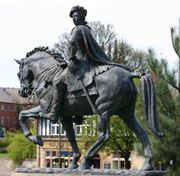
He stayed at Exeter House, Exeter Street where he held his "council of war". A replica of the room is on display at Derby Museum in the city centre. He had received misleading information about an army coming to meet him south of Derby. Although he wished to continue with his quest, he was overruled by his fellow officers. He abandoned his invasion at Swarkestone Bridge on the River Trent just a few miles south of Derby. As a testament to his belief in his cause, the prince - who on the march from Scotland had walked at the front of the column - made the return journey on horseback at the rear of the bedraggled and tired army.
Each year at the beginning of December, the Charles Edward Stuart Society of Derby lead a weekend of activities culminating in a parade through the city centre and a battle on Cathedral Green.
Industrial Revolution
Derby and Derbyshire were centres of Britain's Industrial Revolution. In 1717, Derby was the site of the first water powered silk mill in Britain, built by John Lombe and George Sorocold, after Lombe had reputedly stolen the secrets of silk-throwing from Piedmont in what is now Italy (he is alleged to have been poisoned by Piedmontese as revenge in 1722).
In 1759, Jedediah Strutt patented and built a machine called the Derby Rib Attachment that revolutionised the manufacture of hose. This attachment was used on the Rev. Lee's Framework Knitting Machine; it was placed in front of - and worked in unison with - Lee's Frame, to produce ribbed hose (stockings). The partners were Jedediah Strutt, William Woollatt (who had been joined in 1758 by John Bloodworth and Thomas Stafford, all leading hosiers in Derby). The patent was obtained in January 1759. After three years, Bloodworth and Stafford were paid off, and Samuel Need - a hosier of Nottingham - joined the partnership. The firm was known as Need, Strutt and Woollatt. The patent expired in 1773, though the partnership continued until 1781 when Need died.
| Year | Population[5] |
|---|---|
| 1801 | 14,695 |
| 1851 | 48,506 |
| 1901 | 118,469 |
| 1921 | 142,824 |
| 1941 | 167,321 |
| 1951 | 181,423 |
| 1961 | 199,578 |
| 1971 | 219,558 |
| 1981 | 214,424 |
| 1991 | 225,296 |
| 2001 | 221,716 |
Messrs. Wright, the bankers of Nottingham, recommended that Richard Arkwright apply to Strutt and Need for finance for his cotton spinning mill. The first mill opened in Nottingham in 1770 and was driven by horses. In 1771 Richard Arkwright, Samuel Need and Jedediah Strutt built the world's first water-powered cotton spinning mill at Cromford, Derbyshire, developing a form of power that was to be a catalyst for the Industrial Revolution.
This was followed in Derbyshire by Jedediah Strutt's cotton spinning mills at Belper. They were: South Mill, the first, 1775; North Mill, 1784, which was destroyed by fire on 12 January 1803 and then rebuilt; it started work again at the end of 1804; West Mill, 1792, commenced working 1796; Reeling Mill, 1897; Round Mill, which took 10 years to build, from 1803 to 1813, and commenced working in 1816; and Milford Mills, 1778. The Belper and Milford mills were not built in partnership with Arkwright. These mills were all Strutt owned and financed.
Other famous 18th century figures with connections to Derby include Dr Johnson, the creator of the English dictionary, who married Elizabeth Porter at St. Werburgh's Church, Derby, Derby in 1735; the painter Joseph Wright, known as Wright of Derby, who was famous for his revolutionary use of light in his paintings and was an associate of the Royal Academy; and John Whitehurst, a famous clockmaker and philosopher.
The beginning of the next century saw Derby emerging as an engineering centre with manufacturers such as James Fox, who exported machine tools to Russia.
In 1840, the North Midland Railway set up its works in Derby and, when it merged with the Midland Counties Railway and the Birmingham and Derby Junction Railway, to form the Midland Railway, Derby became its headquarters.
The connection with the railway encouraged others, notably Andrew Handyside, Charles Fox and his son Francis Fox.
Derby was one of the boroughs reformed by the Municipal Corporations Act 1835, and it became a county borough with the Local Government Act 1888. The borough expanded in 1877 to include Little Chester and Litchurch, and then in 1890 to include New Normanton and Rowditch. The borough did not increase substantially again until 1968, when under a recommendation of the Local Government Boundary Commission it was expanded into large parts of the rural district of Belper, Repton and South East Derbyshire. This vastly increased Derby's population from 132,408 in the 1961 census to 219,578 in the 1971 census.[6]
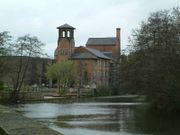
Despite being one of the areas of Britain furthest from the sea, Derby holds a special place in the history of marine safety - it was as MP for Derby that Samuel Plimsoll introduced his bills for a 'Plimsoll line' (and other marine safety measures). This failed on first introduction, but was successful in 1876 and contributed to Plimsoll's re-election as an MP.
20th century to present day
Derby was awarded city status on 7 June 1977 by Queen Elizabeth II to mark the 25th anniversary of her ascension to the throne.[7] The Queen presented the "charter scroll" or 'letters patent' in person on 28 July 1977 on the steps of the Council House to the then Mayor Councillor Jeffrey Tillet (Conservative).[8] Until then, Derby had been one of the few towns in England with a cathedral but not city status.
Derby has a number of public parks, many Victorian in origin. Darley and Derwent parks lie immediately north of the city centre and are home to owls, kingfishers and other wildlife. Derby Rowing Club and Derwent Rowing Club are located on the banks of the river. There is also a riverside walk and cycle path from Darley Park south to two other parks. West of the city centre is Markeaton Park, while to the north is Allestree Park and its lake.
Derby has the first public recreational park in the country to have an arboretum (Derby Arboretum), which lies to the south of the city centre. The arboretum was set up by the philanthropic landowner and industrialist Joseph Strutt in 1840. The arboretum's website states that the arboretum's design was the inspiration for the vision of great urban parks in the USA, notably Central Park in New York City.
Derby holds an important position in the history of the Labour movement, because it was one of two seats (the other being Keir Hardie's in Merthyr Tydfil) gained by the recently formed Labour Representation Committee at the 1900 general election. The MP was Richard Bell, General Secretary of the Railway Servants Union. Bell was succeeded in 1910 by Jimmy Thomas and he in turn by the distinguished polymath and Nobel Laureate Philip Noel-Baker in 1936.
Despite its strategic industries (rail and aero-engine), Derby suffered comparatively little damage in both world wars (contrast Bristol and Filton). This may in part have been due to the jamming of the German radio-beam navigations systems (X-Verfahren and Knickebein, camouflage and decoy techniques ('Starfish sites') were built, mainly south of the town, e.g. out in fields near Foremark (ref. Kirk, Felix & Bartnik, 2002, see talk; see also[9]).
Derby has also become a significant cultural centre for the deaf community in the UK. Many deaf people move to Derby because of its strong sign language-using community. It is estimated that the deaf population in Derby is at least three times higher than the national average, and that only London has a larger deaf population. The Royal School for the Deaf on Ashbourne Road provides education in British Sign Language and English.
Derby has been granted Fairtrade City status.
Governance
By traditional definitions, Derby is the county town of Derbyshire, although Derbyshire's administrative centre has in recent years been Matlock. On 1 April 1997 Derby City Council became again a unitary authority (a status it had held, as a county borough, up until 1974), with the rest of Derbyshire administered from Matlock.
Geography
Derby is split into 17 Wards.[10]
| Ward | Areas within the Ward |
|---|---|
| Abbey | Stockbrook and Normanton (part of) |
| Allestree | Allestree and Markeaton Park |
| Alvaston | Alvaston, Crewton, Litchurch, Pride Park, Wilmorton and Allenton (Part of) |
| Arboretum | City Centre, Pear Tree and Rose Hill |
| Blagreaves | Sunny Hill and Littleover (part of) |
| Boulton | Boulton and Allenton (part of) |
| Chaddesden | Chaddesden |
| Chellaston | Chellaston and Shelton Lock |
| Darley | Darley Abbey, Five Lamps, Little Chester (also known as Chester Green), Strutt's Park and West End |
| Derwent | Breadsall Hilltop and Chaddesden Heights |
| Littleover | Littleover (most of) and Heatherton Village |
| Mackworth | Mackworth and Morley Estate |
| Mickleover | Mickleover |
| Normanton | Normanton (most of) and Austin Estate |
| Oakwood | Oakwood and Chaddesden (part of) |
| Sinfin | Sinfin, Osmaston and Stenson Fields (part of) |
| Spondon | Spondon |
Nearby settlements
 |
Buxton, Bakewell, Manchester, | Duffield, Belper, Matlock | Ilkeston, Heanor, Eastwood, Alfreton, Ripley, Mansfield, Chesterfield, Sheffield |  |
| Ashbourne, Uttoxeter, Stoke on Trent | Nottingham, Borrowash, Breaston, Long Eaton, Beeston | |||
| Burton on Trent, Lichfield, Birmingham | Swadlincote, Castle Donington, Melbourne, Ashby-de-la-Zouche | Kegworth, Loughborough, Leicester |
Industry
Derby's two biggest employers, Rolls-Royce plc and the Toyota Motor Corporation are in engineering manufacturing. Egg, the Internet and telephone bank, has its national base in Derby. Other companies of note include Railway systems engineering firm Bombardier Transportation who manufacture railway rolling stock at the Derby Carriage and Wagon Works, and Alstom who manufacture large power plant boilers and heat exchangers.
Derby was for many years a railway centre, being the former headquarters of the Midland Railway, with both British Rail workshops and research facilities in the town. Although much less important than in years gone by, train manufacture continues in Derby and Derby railway station retains an important position in the railway network. The city is favoured as a site for a national railway centre.[11]
From 1922 Sinfin Lane was the home of the 62 acre site of International Combustion, originally manufacturers of machinery for the automatic delivery of pulverized fuel to furnaces and boilers, and later producing steam-generating boilers for use in electrical generating plant such as used in power stations. In the 1990s the firm was bought by Rolls-Royce plc and then sold on again to ABB Group.[12]
Derby was the home of Core Design, who developed the computer game Tomb Raider with its heroine Lara Croft.
Landmarks
Derby Cathedral tower is 212 feet (68.6 meters) tall to the tip of the pinnacles. This has been home to a pair of breeding peregrine falcons since 2006.[13] Three webcams monitor the falcons here.[14]
Derby Gaol is a visitor attraction based in the dungeons of the Derbyshire County Gaol which dates back to 1756.
Derby Industrial Museum is situated in Derby Silk Mill and shows the industrial heritage and technological achievement of Derby, including Rolls-Royce aero engines, railways, mining, quarrying and foundries.
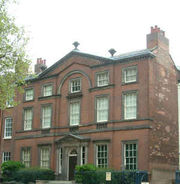
Pickford's House Museum was built by architect Joseph Pickford in 1770. It was his home and business headquarters. Derby Museum and Art Gallery shows paintings by Joseph Wright, as well as fine Royal Crown Derby porcelain, natural history, local regiments and archaeology. Pickford also designed St Helen's House in King Street.
The skyline of the inner city changed in 1968 when the inner ring road with its two new crossings of the River Derwent was built. The route of the ring road went through the St. Alkmund's Church and its Georgian churchyard, the only Georgian square in Derby. Both were demolished to make way for the road, a move still criticised today. Thus the editor (Elizabeth Williamson) of the 2nd edition of Pevsner for Derbyshire wrote:- '...the character and cohesion of the centre has been completely altered by the replacement of a large number of C18 houses in the centre by a multi-lane road. As a traffic scheme this road is said to be a triumph; as townscape it is a disaster.'
The newer buildings along Ford Street and St Alkmund's Way include the Friargate Studios, The Joseph Wright Centre (a campus of Derby College) and the Jurys Inn. The hotel dominates the skyline, demoting nearby St Mary's and, indeed, the Cathedral (silhouettes which formerly described the character of the city). The building of the Jurys Inn has altered well liked approach views of the city such as those from the top of Green Lane, Nottingham Road and from Darley Park.
Places of interest
- Cathedral Quarter
- Darley Abbey
- Derby Arboretum
- Derby Canal
- Derby Cathedral
- Derby Industrial Museum (Silk Mill)
- Derby Friargate Station (of which all that remains is Handyside's bridge across Friargate)
- Markeaton Park Light Railway, a heritage railway
- Pride Park Stadium (Derby County F.C.) and its predecessor the Baseball Ground (now demolished)
- River Derwent
- St Helen's House, Derby
Transport
Roads
The city has extensive transport links with other areas of the country. The M1 motorway passes about ten miles to the east of the city, linking Derby southwards to the London area and northwards to Sheffield and Leeds. Other major roads passing through or near Derby include the A6 (historically the main route from London to Carlisle, also linking to Leicester and Manchester), A38 (Bodmin to Mansfield via Bristol and Birmingham), A50 (Warrington to Leicester via Stoke-on-Trent), A52 (Newcastle-under-Lyme to Mablethorpe, including Brian Clough Way linking Derby to Nottingham) and A61 (Derby to Thirsk via Sheffield and Leeds).
Railways
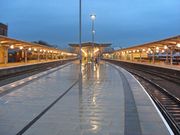
Derby has been served by railways since 1840 with the opening of the North Midland Railway to Leeds, with a route to London via Rugby provided by the Birmingham and Derby Junction Railway. At the same time, a route to Nottingham and Leicester was opened by the Midland Counties Railway. In 1844, these three companies merged to form the Midland Railway who subsequently opened a direct route to London St Pancras station. The present day station, Derby Midland is on the same site as 1840 and the original platform visibly forms the sub-structure of the modern Platform 1. The Midland Railway frontage was replaced in 1985, and during 2008 and 2009 the 1950s concrete platform canopies were replaced with steel and glass structures.
Derby station is operated by East Midlands Trains and the city is served by expresses to London, the North East and South West, provided by East Midlands Trains and CrossCountry. There also remain local stations at Peartree and Spondon, although services are limited, especially at the former.
The Great Northern Railway's "Derbyshire and North Staffordshire Extension" formerly ran through Derby Friargate Station, from Colwick and Nottingham to Egginton Junction. After closure, part of the route west of Derby was used by British Rail as a test track. Today, the trackbed either side of Derby is blocked only by road development and has been converted to a Sustrans cycle track. The ornate cast iron bridge by Andrew Handyside across Friargate is still in place, as is his bridge over the river.
Railway Engineering
As a consequence of the Midland Railway basing their headquarters in Derby, along with their Locomotive and Carriage and Wagon Works, the railways had a major influence on the development of the town during the Victorian period. The locomotive works closed, the land being redeveloped as Pride Park. The only buildings remaining are those visible from Platform 6 of the station. The Carriage and Wagon Works continues to build trains under Bombardier Transportation. Derby's importance on the railway network was underlined by the development of the Railway Technical Centre in the 1960s, which continues to house railway businesses, including the headquarters of DeltaRail Group, formerly the British Rail Research Division.
Air
East Midlands Airport is situated about fifteen miles (24 km) from Derby city centre. Its proximity to Derby, the fact that the airport is in Leicestershire, and the traditional rivalry between the three cities (Derby, Leicester and Nottingham), meant that there was controversy concerning the airport's decision to prefix its name with Nottingham in 2004. In 2006, Nottingham East Midlands Airport reverted to its previous name. The airport is served by budget airlines, including Bmibaby (for which East Midlands is a main base), Ryanair and Jet2, with services to domestic and European destinations. Derby Airfield, located approximately 7 miles southeast of the city centre has grass runways targeted at general aviation.
Bus and coach
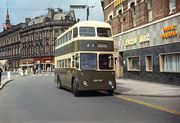
Derby's former bus station was an art deco design by borough architect C.H. Aslin. Built in 1933, it was closed in 2005 and later demolished, despite the protests of environmentalists and conservationists. The unique cafe building is planned to be rebuilt at Crich Tramway Museum. A new bus station has been built on the site as part of the Riverlights development which was opened on Sunday the 28th March 2010. Since the closure of the old bus station, services have been using temporary stops on streets around the Morledge area. Most services in Derby now terminate at the bus station. The new bus station is modern, with 28 bays, 4 for coaches and 24 for general bus services. Only the concourse area, where passengers board and alight, is completed. The remainder of the building is in development which expects to have a Holiday Inn and a Hilton Hotel as well as a convinience store which are due to open in late 2010.
Local bus services in and around Derby are run by a number of companies, but principally Trent Barton and Arriva Midlands. The city is on National Express's London to Manchester and Yorkshire to the South West routes. Additionally a regional route between Manchester and Nottingham is run by Trent Barton via its TransPeak and Red Arrow services.
Between 1932 and 1967, Derby Corporation operated a trolleybus system. The last trolleybus ran on 9 September 1967. Several Derby vehicles have been preserved at Sandtoft and the East Anglia Transport Museum.
Culture, entertainment and sport
Music
The annual open-air concert at Darley Park is one of the biggest free concerts of its kind. It is one of many performances given throughout the year by Sinfonia Viva, a professional chamber orchestra based in Derby. The Derby Jazz group caters for the jazz interest in the city and is regarded as one of the UK's leading live jazz organisations. There is also a summer rock music festival Prom in the Park which takes place in late July every year. The three piece rock band LostAlone are from and based in Derby and are signed to Warner Brothers Records. A full-scale programme of orchestral and other concerts is presented at the Assembly Rooms. A thriving amateur classical music scene includes two choral societies, Derby Bach Choir and Derby Choral Union, smaller choirs, including the Derwent Singers and Sitwell Singers, and Derby Concert Orchestra. Derby Chamber Music presents an annual series of chamber music concerts at Derby University's Multi-Faith Centre. A series of organ recitals is presented every summer at Derby Cathedral, featuring leading international performers. An active folk-music scene includes the annual Derby Traditional Music and Arts Festival.
Theatre and arts
Derby Playhouse regularly received acclaim in the national press for its productions, particularly, in recent years, for its staging of shows by Stephen Sondheim. After a lengthy period of financial uncertainty, the theatre closed in February 2008. It was resurrected in September of that year after a new financing package was put together but forced to close again just two months later because of further financial problems. The lease was later bought by Derby University. Renamed Derby Theatre, it has joined the Assembly Rooms and Guildhall Theatre as one of the venues operated by Derby LIVE, the cultural arm of Derby City Council. The theatre annually hosts the Derby Gilbert & Sullivan Company.
QUAD See Derby QUAD is a centre for art and film which opened on in 2008. The building has two cinema screens showing independent and mainstream cinema, two gallery spaces housing contemporary visual arts, a digital studio, participation spaces, digital editing suites, artists studio and the bfi Mediatheque.
The Robert Ludlam Theatre is a 270 seat venue with a programme of entertainment including dance, drama, art, music, theatre in the round, comedy, films, family entertainment, rock and pop events, workshops and provides a home for many of Derbyshire's amateur production groups.
Among Derby's many amateur theatre groups, Derby Shakespeare Theatre Company has received critical acclaim for its often innovative productions, and is regularly invited to appear at the Minack Theatre in Cornwall.
Derby Festé is a spectacular weekend street arts festival held every September.
John Dexter the theatre director and the actor Alan Bates were from Derby.
Sport
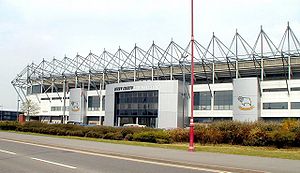
Derby is home to several sports clubs.
Derby County, who were FA Cup winners in 1946, Football League champions in 1972 and again in 1975, and are members of the Football League Championship. They have played at Pride Park Stadium since 1997, having been previously based at the Baseball Ground, a stadium built in 1890 as a baseball stadium. One notable baseball player and famous footballer was the Derby legend Steve Bloomer, the baseball was discontinued when the sport failed to attract support. Former managers include Brian Clough, Arthur Cox, Jim Smith, John Gregory and George Burley. Former players include Colin Todd, Roy McFarland (who both later had brief and unsuccessful stints as manager at the club), Peter Shilton, Dean Saunders, Craig Short, Marco Gabbiadini, Horacio Carbonari, Steve Bloomer and Tom Huddlestone.
There are three senior non-league football clubs based in the city. Mickleover Sports play at Station Road, Mickleover and are members of the UniBond League Division One South (the eighth level of the English football league system). Graham Street Prims and Borrowash Victoria are both members of the East Midlands Counties League (level ten) and play on adjacent grounds at the Asterdale complex in Spondon.
Derbyshire County Cricket Club are based at the County Ground in Derby and play almost all home matches there, although matches at Chesterfield were re-introduced in 2006. One of the designated first class county sides, they have won the County Championship once, in 1936.
Derby has clubs in both codes of rugby. In rugby union, Derby RFC play in Midlands Division Two East (the seventh level of English rugby union) at their Haslams Lane ground. Rugby league team Derby City RLFC were formed in 1990 and compete in the Midlands Premier Division of the National Rugby League Conference. From 2008 they are ground sharing with Derby RFC at Haslams Lane.
The city is represented in the English Basketball League Division One by Derby Trailblazers, who play at the Moorways Sports Centre. They were formed in 2002 following the demise of British Basketball League side Derby Storm.
Local industrialist Francis Ley introduced baseball to the town in the late 19th century, and built a stadium near the town centre. The attempt to establish baseball in Derby was unsuccessful, but the stadium survived for some 100 years afterwards as the home of Derby County Football Club. It was demolished in 2003, six years after County's move to Pride Park.
Arthur Keily the marathon runner and Olympian was born in Derbyshire in 1921 and has lived his whole life in Derby. In Rome in 1960 he broke the English Olympic record, recording a time of 2hours 27mins.[15][16]
Recreation
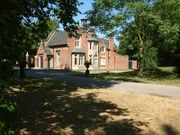
Derby Arboretum was the first public park in the country and is thought to have been one of the inspirations for Central Park in New York. Although it suffered from neglect in the 1990s, it has been renovated.
Markeaton Park is Derby's most used leisure facility.[17] It is the venue for the city council's annual Guy Fawkes Night firework display and contains its own light railway. Other major parks in the city include Allestree Park, Darley Park, Chaddesden Park, Alvaston Park, Normanton Park and Osmaston Park.
There are four museums: Derby Museum and Art Gallery; Pickford's House Museum; The Silk Mill and The Royal Crown Derby Museum.
Shopping and nightlife
Shopping in Derby is divided into two main areas. The first is the Westfield Shopping Centre, controlled by the Westfield Group. The second is the older section known as the Cathedral Quarter. This area includes a range of boutiques and coffee shops and is focused around the cathedral and the area around Irongate.
Westfield Derby (incorporating the former Eagle Centre) is the city's main indoor shopping centre. It opened in 2007 after extension work costing £340 million. It contains a food court and a 12-screen cinema (Showcase - Cinema De Lux) which was opened in May 2008. The development was controversial and local opponents accuse it of drawing trade away from the older parts of the city centre where independent shops have traditionally been located. Some of these have experienced a downturn in trade and some have ceased trading since the development opened. In Westfield itself, a combination of high rents and rising rates have made things difficult for smaller traders.[18]
The Friar Gate area contains clubs and bars, making it the centre of Derby's nightlife. Derby is also well provided with pubs.
Education
Like most of the UK, Derby operates a non-selective primary and secondary education system with no middle schools. Pupils attend infant and junior school (often in a combined primary school) before moving onto a comprehensive secondary school. Many secondaries also have sixth forms, allowing pupils to optionally continue their education by taking A Levels after the end of compulsory education at age 16. For those who want to stay in education but leave school, the large Derby College provides a number of post-16 courses.
Outside the state sector, there are four fee-paying independent schools. Derby Grammar School was founded in 1994 and was for boys only, until 2007, when they accepted girls into the sixth form for the first time, who aim to continue the work and traditions of the former Derby School, closed in 1989, one of the oldest schools in England; Derby High School is for girls-only at secondary level and for boys at primary level; and Ockbrook School is an independent school for girls aged 3–18) and boys aged 3–11). Michael House Steiner School can be found in Shipley, Heanor and caters for pupils from kindergarten age through to 16.
Derby has an academy, Landau Forte College, partially state-funded, but also with business backing. It was one of fifteen City Technology Colleges set up in the late 1980s and early 1990s, which was converted into a City Academy in September 2006.
Derby has special needs establishments including Ivy House School (which takes pupils from nursery to sixth form) and the Light House which is a respite facility for children and parents.
The University of Derby has its main campus on Kedleston Road. There is another campus in north Derbyshire at Buxton.
In 2003 the University of Nottingham opened a graduate entry medical school based at Derby City General Hospital.
Media
The Derby Telegraph, formerly the Derby Evening Telegraph, is the city's daily newspaper. In addition, a free newspaper, the Derby Express, is delivered to households weekly. The former free Derby Trader weekly newspaper is no longer in print. The daily freesheet 'Metro' is distributed in the city centre every morning, although this only has a very small amount of local content. Another local paper is the weekly Derbyshire Times published every Thursday, which mainly covers news from the north of the county.
BBC Radio Derby, the BBC's local station for Derbyshire and East Staffordshire, is based on St. Helen's Street in the city and offers local, national and international news, features, music and sports commentaries. It has around 150,000 weekly listeners and is available on 104.5 FM and 1116 AM, on 95.3 FM in North and Mid Derbyshire and on 96.0 FM in the Buxton area, as well as being streamed on the internet. The BBC in Derby have their own local website for the area which provides news, travel and weather information, as well as other features. From 1983 to 2008 Radio Derby organised the Money Mountain Appeal, an annual on-air charity auction which raised more than £1 million for local causes. Since July 2007, the BBC has managed Big Screen Derby in the Market Place in conjunction with Derby City Council and the University of Derby, as part of the BBC Big Screen project.
Ram FM, the independent local radio station for Derbyshire and East Staffordshire, is based in the city and offers adult contemporary music and entertainment, with news and traffic bulletins. It broadcasts on 102.8 FM, is streamed on the Internet, and is listened to by around 120,000 people each week. Ram FM is part of the Global Radio Hit Music Network, and hosts local events, such as the Darley Park Concert, the city bonfire and fireworks, the Christmas lights switch-on, and the Race For Life, raising money for Cancer Research UK.
The city emblem
- Derby's emblem is the Derby Ram, about which there is a folk song entitled "The Derby Ram". It is found in a number of places, most notably in the nickname of Derby County FC of "The Rams." A stylised depiction forms the logo of the City Council's services. A ram provided by the Duke of Devonshire is the mascot of the Worcestershire and Sherwood Foresters Regiment from the 95th (Derbyshire) Regiment of Foot which was incorporated within it.
- Bold Lane Car Park in Derby is one of the top ten most secure places in the world according to a study published in a science magazine.[19]
Notable people
- Alan Bates (1934–2003), actor.
- Ronald Binge (1910–1979), composer - light classical music.
- David Brailsford (1964), Performance director of British Cycling.
- Maxwell Caulfield (1959), actor.
- Henry Cavendish (1731–1810), scientist.
- William John Coffee (1774–1846), artist and sculptor.
- Daniel Parker Coke (1745–1825), barrister and Member of Parliament.
- Erasmus Darwin (1731–1802), physician.
- John Flamsteed (1646–1719), first Astronomer Royal.
- James Fox (1780–1830), engineer.
- Georgia Groome (1992), actress.
- Bobby Hassell(born 1980), footballer.
- Andrew Handyside (1806–1887), iron founder.
- Geoff Hoon MP (born 1953), politician.
- William Hutton (1723–1815) historian, poet and bookseller.
- Stephen Layton (born 1966), choral conductor
- John Lombe (1693–1722), industrial pioneer.
- Stephen Marley (born 1946), novelist.
- Florence Nightingale (1820–1910), pioneer of modern nursing.
- Jack O'Connell (actor) (born 1989), actor.
- Colin Osborne (born 1975), PDC Darts professional.
- Samuel Plimsoll (1825–98), politician, Liberal Member of Parliament for Derby (1868–80). The Plimsoll line -'The Sailors Friend'.
- Samuel Richardson (1689–1761), novellist.
- Sir Henry Royce (1863–1933), co-founder of Rolls-Royce.
- Sir Nigel Rudd (Born 1946), Industrialist.
- George Sorocold (1668?-1738?), The first non military person to be described as an engineer.
- Chris Palmer (Born 1983), professional footballer.
- Herbert Spencer (1820–1903), philosopher.
- Jedediah Strutt (1726–1797), industrial pioneer.
- Chris Riggott (Born 1980), professional footballer.
- John Whitehurst (1713–1788), clockmaker and scientist.
- Sir Henry Wilmot (1831–1901), recipient of the Victoria Cross.
- Joseph Wright (1734–1797), painter.
- Lee Camp (born 1984), professional footballer.
- Richard Sloman (Born 1985) Professional hacker
- Damien Walters (born 1982), stuntman, gymnast and free runner [20]
- Tim "livewire" Shieff (born 1988), free runner - Current free running world champion [21]
International relations
Twin towns
Derby is twinned with Osnabrück in Germany. The partnership treaty between the two cities was signed on 17 February 1976.
The twinning agreement with Derby was signed in 1976 in the historical Hall of Peace in Osnabrück's Rathaus (town hall). Every year, Derby and Osnabrück each appoint an envoy who spends twelve months in the twin city. The envoy promotes the exchange of ideas between the two cities and acts as an educational and information officer to increase awareness of the twinning scheme. The envoy gives talks to local societies and schools, finds pen friends and short term host families during work placements, works to assist groups who want to get involved in twinning by identifying and approaching possible counterparts and plans the annual mayweek trip.
There is an annual exchange between the wind bands of John Port School, Etwall and its twin school Gymnasium Melle in Osnabrück. From 2009 on there is also an exchange beween Woodlands Community School, Allestree and the Gymnasium Angelaschule in Osnabrück. This exchange is based on a drama-project of both schools in June 2009, which contained performances in both cities with over 1600 visitors.
The exchange of envoys between two cities is very unusual. The envoy in Osnabrück changes every year and Osnabrück also sends envoys to Derby, Angers and Çanakkale. No other city in Germany participates in this exchange of envoys, and in Britain, only one other town, Wigan, receives and sends an envoy.
List of international links
 - Kapurthala, India (friendship link)
- Kapurthala, India (friendship link)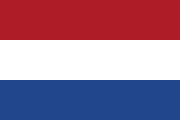 - Haarlem, Netherlands (friendship link)
- Haarlem, Netherlands (friendship link) - Foncquevillers, France (friendship link)
- Foncquevillers, France (friendship link) - Toyota City, Japan
- Toyota City, Japan - Changzhi, China (Memorandum of Understanding)
- Changzhi, China (Memorandum of Understanding)
Gallery
 The cathedral from Green Lane |
 Part of the Rolls-Royce Works |
 Nurses' Home |
 Old College |
 Sure Start, Normanton |
 St Matthew's, Darley Abbey |
 St Mary's-on-the-Bridge |
 St Luke's, Stockbrook Street |
 The Falstaff public house, Normanton |
 St John's, Bridge Street |
|
Part of the Westfield Centre |
Bust of Steve Bloomer at Pride Park Stadium |
Westfield from Babington Lane |
Islamic Centre, Wilmot Street |
Ex Prison., Ex Greyhound Stadium |
|
St Mary's RC Church |
Spa Inn, Abbey Street |
Derby Cathedral and the Dolphin Inn |
Guru Arjan Dev Gurdwara |
Derby Moor Community Sports College and the Millennium Sixth Form Centre |
|
Joseph Wright, St Alkmunds Way |
Friar Gate Studios, Ford Street |
New Jury's Inn St Alkmond's Way |
Roundhouse Derby near completion |
References
- ↑ http://www.neighbourhood.statistics.gov.uk/
- ↑ "Business Link East Midlands". http://www.businesslink.gov.uk/bdotg/action/layer?site=140&topicId=5001304536. Retrieved 2009-11-29.
- ↑ "Derby Cathedral". You & Yesterday. http://www.youandyesterday.co.uk/articles/Derby_Cathedral. Retrieved 2008-02-04.
- ↑ The Rivers of Time Ron McKeown, ISBN 0-9530603-7-3
- ↑ "Derby District: Total Population". A Vision of Britain Through Time. Great Britain Historical GIS Project. http://www.visionofbritain.org.uk/data_cube_table_page.jsp?data_theme=T_POP&data_cube=N_TPop&u_id=10033032&c_id=10001043&add=N. Retrieved 2007-04-28.
- ↑ http://www.visionofbritain.org.uk/data_cube_table_page.jsp?data_theme=T_POP&data_cube=N_TPop&u_id=10109700&c_id=10001043&add=N
- ↑ London Gazette: no. 47246, p. 7656, 14 June 1977. Retrieved 2007-11-21.
- ↑ The Times. July 29, 1977
- ↑ "Stories". Youandyesterday.co.uk. 1942-07-27. http://www.youandyesterday.co.uk/articles/WWII:_How_film_sets_saved_Derby_at_war. Retrieved 2010-07-17.
- ↑ The Local Government Commission for England (June 2001). __E__.pdf "Periodic electoral review of Derby: Final recommendations for ward boundaries in Derby" (PDF). http://www.boundarycommittee.org.uk/files/dms/derby-map-large_a=Continue_7177-4418 __E__.pdf. Retrieved 2008-02-04.
- ↑ [1]
- ↑ International Combustion Ltd from American roots to Sinfin Lane at bygonederbyshire.co.uk
- ↑ "Peregrine Project". Derby Council website. http://www.derby.gov.uk/LeisureCulture/MuseumsGalleries/EnvironmentalProjects/PeregrineProject.htm. Retrieved 2008-02-04.
- ↑ "Derby Peregrine Webcam". 195.224.106.202. http://195.224.106.202/peregrine/webcam2.htm. Retrieved 2010-07-17.
- ↑ "Olympian Arthur keily picks up lifetime achievement award". Derby Telegraph. http://www.thisisderbyshire.co.uk/news/Derby-Olympian-Arthur-Keily-picks-lifetime-achievement-gong/article-341566-detail/article.html. Retrieved 2009-05-26.
- ↑ "keily, Arthur". bygonederbyshire. http://bygonederbyshire.co.uk/articles/Arthur_Keily. Retrieved 2009-05-26.
- ↑ Markeaton Today BBC.co.uk Accessed August 29, 2007
- ↑ "Westfield Derby - About". westfieldderby.co.uk. http://www.westfieldderby.co.uk/about.htm. Retrieved 2008-02-04.
- ↑ "Derby - Features - Bold Lane Car Park". BBC. http://www.bbc.co.uk/derby/features/2004/02/bold_lane/index.shtml. Retrieved 2010-07-17.
- ↑ "Damien Walters - Free Running Wiki". Streetstunts.net. http://www.streetstunts.net/wiki/Damien_Walters. Retrieved 2010-07-17.
- ↑ "Tim Shieff - Free Running Wiki". Streetstunts.net. http://www.streetstunts.net/wiki/Tim_Shieff. Retrieved 2010-07-17.
External links
- Online Guide to Derby
- Bygone Derbyshire website
- Twinning link with Osnabrück
- Derby City Council website
- artsderbyshire.org.uk - Derby and Derbyshire arts guide
|
|||||
|
|||||||||||||||||
|
|||||
|
||||||||||||||
|
|||||||||||
|
||||||||||

